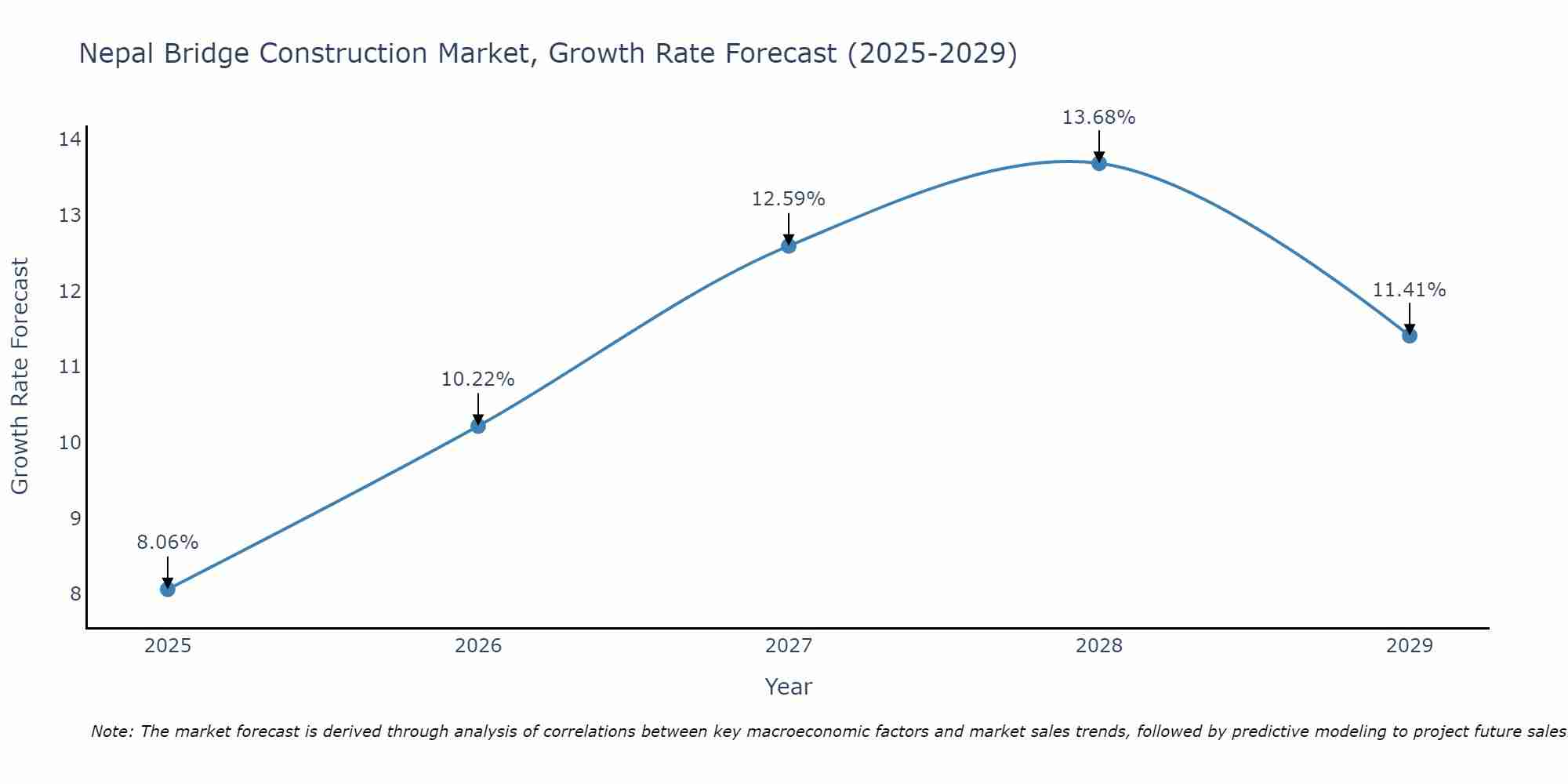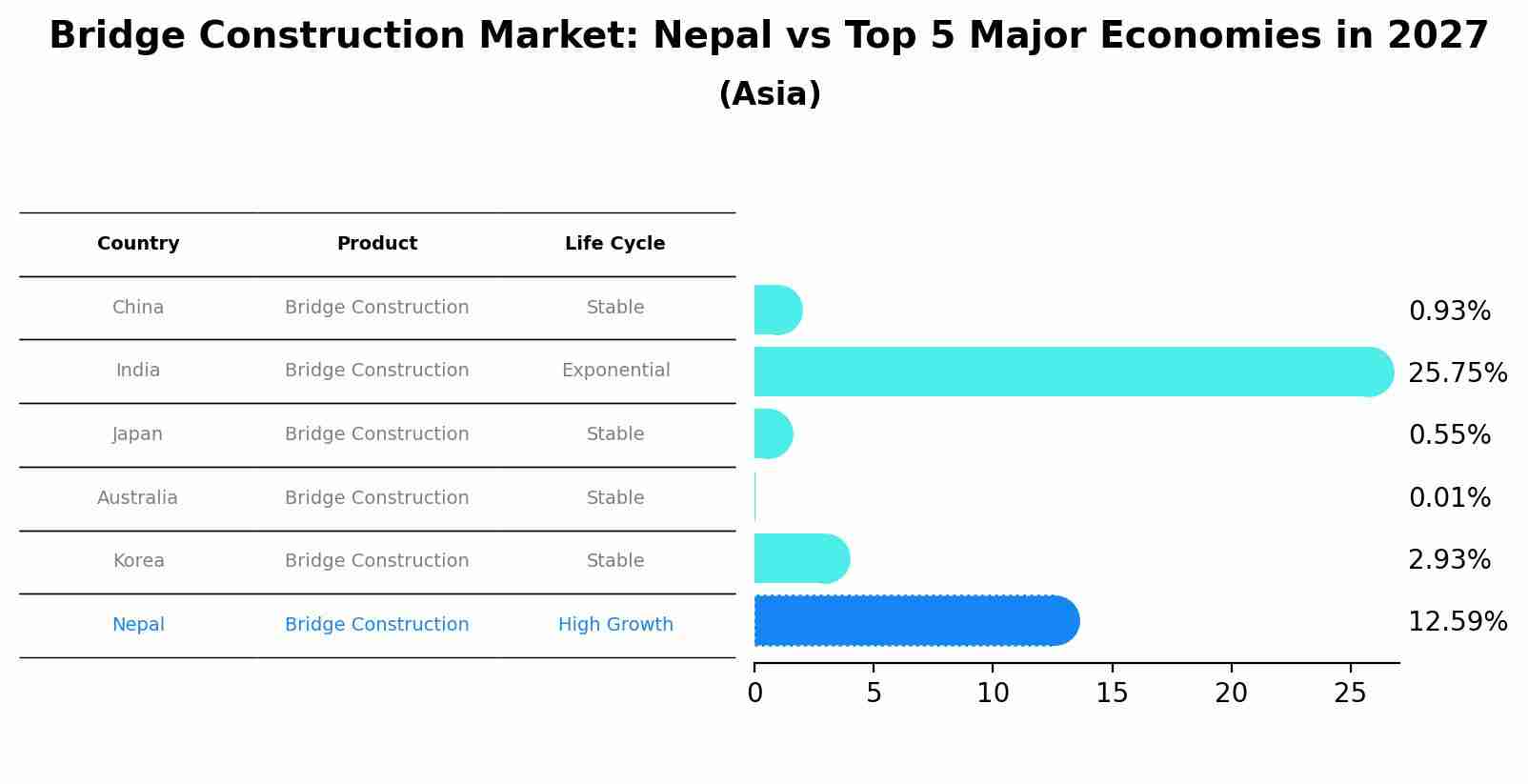Nepal Bridge Construction Market (2025-2031) Outlook | Value, Size, Trends, Revenue, Forecast, Industry, Analysis, Growth, Share & Companies
| Product Code: ETC360096 | Publication Date: Aug 2022 | Updated Date: Aug 2025 | Product Type: Market Research Report | |
| Publisher: 6Wresearch | Author: Shubham Padhi | No. of Pages: 75 | No. of Figures: 35 | No. of Tables: 20 |
Nepal Bridge Construction Market Size Growth Rate
The Nepal Bridge Construction Market is projected to witness mixed growth rate patterns during 2025 to 2029. Growth accelerates to 13.68% in 2028, following an initial rate of 8.06%, before easing to 11.41% at the end of the period.

Bridge Construction Market: Nepal vs Top 5 Major Economies in 2027 (Asia)
By 2027, Nepal's Bridge Construction market is forecasted to achieve a high growth rate of 12.59%, with China leading the Asia region, followed by India, Japan, Australia and South Korea.

Nepal Bridge Construction Market Synopsis
The Nepal Bridge Construction Market is experiencing steady growth due to increasing infrastructure development projects in the country. The demand for new bridges and the renovation of existing ones is being driven by government initiatives to improve transportation connectivity and support economic growth. The market is witnessing a rise in the construction of various types of bridges including suspension bridges, arch bridges, and beam bridges, to connect remote areas and enhance accessibility. Key players in the market are focusing on innovative bridge construction techniques, sustainable materials, and cost-effective solutions to meet the growing demand. Additionally, the implementation of stringent safety regulations and quality standards is further shaping the market landscape, ensuring durable and reliable bridge structures for the country`s infrastructure development.
Nepal Bridge Construction Market Trends
In the Nepal bridge construction market, several key trends are emerging. Firstly, there is a growing focus on sustainability and environmentally friendly construction practices, with an increasing emphasis on using eco-friendly materials and designs to minimize the environmental impact of bridge projects. Secondly, there is a demand for innovative and cost-effective bridge designs that can withstand the country`s challenging terrain and weather conditions. Additionally, the adoption of advanced technologies such as Building Information Modeling (BIM) and drone surveys is on the rise, enabling more efficient and accurate bridge construction processes. Lastly, there is a push towards enhancing connectivity and infrastructure development across Nepal, leading to a rise in bridge construction projects aimed at improving transportation networks and promoting economic growth in the region.
Nepal Bridge Construction Market Challenges
In the Nepal bridge construction market, several challenges are prevalent. These include issues related to inadequate infrastructure planning, limited technical expertise, and insufficient funding for large-scale bridge projects. The rugged terrain and diverse geological conditions in Nepal also pose challenges in terms of construction logistics and engineering complexities. Additionally, bureaucratic red tape and regulatory hurdles can slow down project timelines and increase costs. Lack of standardized guidelines and quality control measures further impact the overall construction process and the longevity of the bridges. Addressing these challenges will be crucial for the sustainable development of the bridge construction market in Nepal and ensuring the safe and efficient connectivity of various regions in the country.
Nepal Bridge Construction Market Investment Opportunities
The Nepal bridge construction market offers promising investment opportunities due to the country`s increasing focus on infrastructure development and connectivity improvement. With Nepal`s rugged terrain and numerous rivers, there is a growing demand for bridges to connect remote areas and enhance transportation networks. Investors can consider opportunities in the construction of various types of bridges, including suspension bridges, cable-stayed bridges, and concrete bridges. Additionally, the government`s initiatives to upgrade road networks and enhance trade links with neighboring countries further support the growth of the bridge construction sector. Investing in bridge construction projects in Nepal can offer long-term returns and contribute to the country`s economic development by improving accessibility and connectivity for both people and goods.
Jordan Agar Market Government Policies
In Nepal, the government has implemented policies to promote the development of the bridge construction market. The Department of Roads (DoR) is responsible for overseeing the planning, design, and construction of bridges in the country, ensuring compliance with safety and quality standards. The government has allocated budgets for infrastructure development projects, including the construction of bridges, to improve connectivity and facilitate economic growth. Additionally, the government has introduced measures to encourage private sector participation in bridge construction projects through public-private partnerships (PPPs) and tender processes. These policies aim to enhance infrastructure development, bridge connectivity gaps, and create opportunities for both local and international companies in the Nepal bridge construction market.
Nepal Bridge Construction Market Future Outlook
The future outlook for the Nepal Bridge Construction Market appears promising, driven by the country`s increasing infrastructure development initiatives and efforts to enhance connectivity. With the government`s focus on improving transportation networks and accessibility to remote regions, there is a growing demand for new bridge construction projects across Nepal. Additionally, the influx of foreign investments and collaborations in the infrastructure sector is expected to further boost the market growth. As Nepal continues to prioritize infrastructure development as a key driver of economic growth, the bridge construction market is likely to witness steady expansion in the coming years, presenting opportunities for construction companies, material suppliers, and engineering firms to participate in the country`s infrastructure development journey.
Key Highlights of the Report:
- Nepal Bridge Construction Market Outlook
- Market Size of Nepal Bridge Construction Market, 2024
- Forecast of Nepal Bridge Construction Market, 2031
- Historical Data and Forecast of Nepal Bridge Construction Revenues & Volume for the Period 2021 - 2031
- Nepal Bridge Construction Market Trend Evolution
- Nepal Bridge Construction Market Drivers and Challenges
- Nepal Bridge Construction Price Trends
- Nepal Bridge Construction Porter's Five Forces
- Nepal Bridge Construction Industry Life Cycle
- Historical Data and Forecast of Nepal Bridge Construction Market Revenues & Volume By Type for the Period 2021 - 2031
- Historical Data and Forecast of Nepal Bridge Construction Market Revenues & Volume By Beam Bridge for the Period 2021 - 2031
- Historical Data and Forecast of Nepal Bridge Construction Market Revenues & Volume By Truss Bridge for the Period 2021 - 2031
- Historical Data and Forecast of Nepal Bridge Construction Market Revenues & Volume By Arch Bridge for the Period 2021 - 2031
- Historical Data and Forecast of Nepal Bridge Construction Market Revenues & Volume By Suspension Bridge for the Period 2021 - 2031
- Historical Data and Forecast of Nepal Bridge Construction Market Revenues & Volume By Cable-Stayed Bridge for the Period 2021 - 2031
- Historical Data and Forecast of Nepal Bridge Construction Market Revenues & Volume By Others for the Period 2021 - 2031
- Historical Data and Forecast of Nepal Bridge Construction Market Revenues & Volume By Material for the Period 2021 - 2031
- Historical Data and Forecast of Nepal Bridge Construction Market Revenues & Volume By Steel for the Period 2021 - 2031
- Historical Data and Forecast of Nepal Bridge Construction Market Revenues & Volume By Concrete for the Period 2021 - 2031
- Historical Data and Forecast of Nepal Bridge Construction Market Revenues & Volume By Composite Material for the Period 2021 - 2031
- Historical Data and Forecast of Nepal Bridge Construction Market Revenues & Volume By Application for the Period 2021 - 2031
- Historical Data and Forecast of Nepal Bridge Construction Market Revenues & Volume By Road & Highway for the Period 2021 - 2031
- Historical Data and Forecast of Nepal Bridge Construction Market Revenues & Volume By Railway for the Period 2021 - 2031
- Nepal Bridge Construction Import Export Trade Statistics
- Market Opportunity Assessment By Type
- Market Opportunity Assessment By Material
- Market Opportunity Assessment By Application
- Nepal Bridge Construction Top Companies Market Share
- Nepal Bridge Construction Competitive Benchmarking By Technical and Operational Parameters
- Nepal Bridge Construction Company Profiles
- Nepal Bridge Construction Key Strategic Recommendations
Frequently Asked Questions About the Market Study (FAQs):
- Single User License$ 1,995
- Department License$ 2,400
- Site License$ 3,120
- Global License$ 3,795
Search
Thought Leadership and Analyst Meet
Our Clients
Related Reports
- Canada Oil and Gas Market (2026-2032) | Share, Segmentation, Value, Industry, Trends, Forecast, Analysis, Size & Revenue, Growth, Competitive Landscape, Outlook, Companies
- Germany Breakfast Food Market (2026-2032) | Industry, Share, Growth, Size, Companies, Value, Analysis, Revenue, Trends, Forecast & Outlook
- Australia Briquette Market (2025-2031) | Growth, Size, Revenue, Forecast, Analysis, Trends, Value, Share, Industry & Companies
- Vietnam System Integrator Market (2025-2031) | Size, Companies, Analysis, Industry, Value, Forecast, Growth, Trends, Revenue & Share
- ASEAN and Thailand Brain Health Supplements Market (2025-2031) | Strategy, Consumer Insights, Analysis, Investment Trends, Opportunities, Growth, Size, Share, Industry, Revenue, Segments, Value, Segmentation, Supply, Forecast, Restraints, Outlook, Competition, Drivers, Trends, Demand, Pricing Analysis, Competitive, Strategic Insights, Companies, Challenges
- ASEAN Bearings Market (2025-2031) | Strategy, Consumer Insights, Analysis, Investment Trends, Opportunities, Growth, Size, Share, Industry, Revenue, Segments, Value, Segmentation, Supply, Forecast, Restraints, Outlook, Competition, Drivers, Trends, Demand, Pricing Analysis, Competitive, Strategic Insights, Companies, Challenges
- Europe Flooring Market (2025-2031) | Outlook, Share, Industry, Trends, Forecast, Companies, Revenue, Size, Analysis, Growth & Value
- Saudi Arabia Manlift Market (2025-2031) | Outlook, Size, Growth, Trends, Companies, Industry, Revenue, Value, Share, Forecast & Analysis
- Uganda Excavator, Crane, and Wheel Loaders Market (2025-2031) | Strategy, Consumer Insights, Analysis, Investment Trends, Opportunities, Growth, Size, Share, Industry, Revenue, Segments, Value, Segmentation, Supply, Forecast, Restraints, Outlook, Competition, Drivers, Trends, Demand, Pricing Analysis, Competitive, Strategic Insights, Companies, Challenges
- Rwanda Excavator, Crane, and Wheel Loaders Market (2025-2031) | Strategy, Consumer Insights, Analysis, Investment Trends, Opportunities, Growth, Size, Share, Industry, Revenue, Segments, Value, Segmentation, Supply, Forecast, Restraints, Outlook, Competition, Drivers, Trends, Demand, Pricing Analysis, Competitive, Strategic Insights, Companies, Challenges
Industry Events and Analyst Meet
Whitepaper
- Middle East & Africa Commercial Security Market Click here to view more.
- Middle East & Africa Fire Safety Systems & Equipment Market Click here to view more.
- GCC Drone Market Click here to view more.
- Middle East Lighting Fixture Market Click here to view more.
- GCC Physical & Perimeter Security Market Click here to view more.
6WResearch In News
- Doha a strategic location for EV manufacturing hub: IPA Qatar
- Demand for luxury TVs surging in the GCC, says Samsung
- Empowering Growth: The Thriving Journey of Bangladesh’s Cable Industry
- Demand for luxury TVs surging in the GCC, says Samsung
- Video call with a traditional healer? Once unthinkable, it’s now common in South Africa
- Intelligent Buildings To Smooth GCC’s Path To Net Zero


















